Celebrating Midwives
Celebrating Midwives
Midwives save lives. Well-trained midwives could help avert roughly two thirds of all maternal and newborn deaths. They could also deliver 87 per cent of all essential sexual, reproductive, maternal and newborn health services. Yet only 42 per cent of people with midwifery skills work in the 73 countries where more than 90 per cent of all maternal and newborn deaths and stillbirths occur.
UNFPA works with partners, governments and policymakers to help build a competent, well-trained and well-supported midwifery workforce in low-resource settings. UNFPA focuses on four key areas: strengthening competency-based midwifery training; developing strong regulatory mechanisms to ensure quality services; raising the voices of midwives by establishing and strengthening midwifery associations; and advocating for increased investments in midwifery services. UNFPA also works to create a supportive environment for midwives by advocating for adequate workforce policies for midwives.
This collection of portraits of midwives from across the Asia-Pacific region invites us to reflect on the life-saving work of these truly remarkable women.
The State of the World’s Midwifery Report 2021
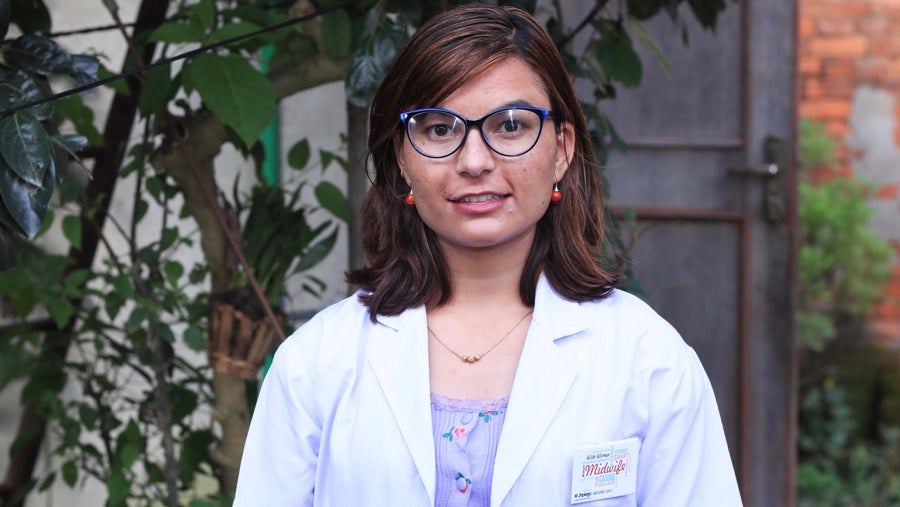
Nepal: “We empower young women by talking about the danger signs that can happen during pregnancy and after childbirth,” says Prasansha Budha Lama. “We talk about respectful maternity care and gentle birth methods and what special preparation they can do during the pregnancy to avoid complications and to manage the complications.”
Prasansha is part of the first batch of professional midwives of Nepal - one of 14 in the whole country, as of early 2021. When COVID-19 shut things down in March 2020, she and her midwife friends set up an emergency hotline number to keep women and girls connected during their pandemic pregnancies. With support from various organizations and donors, they started a programme called Childbirth Education for Young People in Nepal in association with the Midwifery Society of Nepal, Rural Community Health Care Nepal, the Nepal society of Obstetricians and Gynaecologists, and the online maternal health portal and app, Amakomaya (A Mother's Love). They enrolled young women under 25 years and provided education about pregnancy, including physiological changes, and care before, during, and after pregnancy. READ MORE

Kiribati: “I wanted to deliver babies and become a midwife,” says Taroaua Nio. She’s a midwife in Tarawa, the atoll-capital of the Pacific nation of Kiribati. “I think childbirth is one of the most amazing things you could ever experience, and I loved working with people and seeing the happiness of families when they welcome their new bundle of joy.” ©UNFPA/Pacific

Timor-Leste: “I am happy because I can help my fellow mothers and their babies,” says Midwife Ana Maria Sarmento. She has been helping deliver babies for more than 25 years in Timor-Leste where health systems remain weak, although strengthened investments in recent years are beginning to show results.
“We face a lot of challenges in our daily work,” she says. “Sometimes, I have to assist with deliveries at a home in a village. I will walk to the village while carrying the equipment bag. Sometimes I can go by motorbike, other times I have to ride a horse with the family members to reach their home and assist the mother during childbirth.”
Ana says the transport barriers can become a matter of life- and-death. “If there is a complication, we have to get the mother back to the health facility,” she says. “If the ambulance is not available, we transport her in a mini truck.”
She says she is grateful for the improved water system that helps her deliver better care. “Now we have a good water supply,” she says. “Before when we had no water supply, we requested the family member of the patient to bring one or two gallons of water to assist the delivery process. If there is no electricity, we will light a candle or use a rechargeable flashlight to assist during the childbirth.” ©UNICEF/Porritt

Fiji: UNFPA mobilizes retired midwives to deliver lifesaving sexual and reproductive health services in disaster zones in the Pacific. Kelera Rabuka is a retired midwife from Fiji. She was deployed to multiple emergencies across the Pacific to ensure women’s dignity in receiving respectful maternity care and to support safe outcomes for mothers and babies, even in the midst of a disaster. A group of Fijian midwives was dispatched as well to Samoa amid its devastating measles outbreak to support pregnant women and new mothers. ©UNFPA/Black LEARN MORE- VIDEO
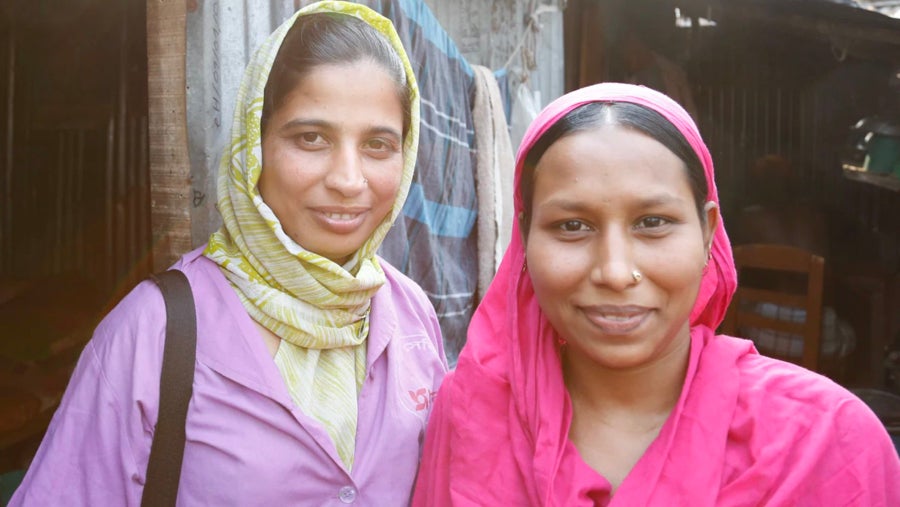
Bangladesh: The informal settlements of Dhaka are chaotic, overcrowded and under-resourced. For pregnant women with few resources, it can be a challenge just to get to the health center for antenatal care. Even more tenuous are the links between midwives and obstetrics units in referral hospitals. UNFPA is bridging that gap and saving lives through an app that helps doctors, nurses, midwives and drivers work together as a team. ©UNFPA/Bangladesh READ MORE

Bangladesh: “I was a midwife in Myanmar," Rohingya refugee Anowara says. "I’ve been doing this since my first-born could crawl and she’s now 18 years old.” She is a midwife volunteer at the Primary Health Centre in Camp 18, Kutupalong-Balukhali mega-camp in Cox’s Bazar. Anowara has helped deliver more than 300 babies. In the refugee camps, a network of primary health centres provide round-the-clock routine maternal and neonatal care. The focus is on persuading mothers to make use of the expanded services, including antenatal check-ups and the delivery of their babies under proper medical supervision. ©UN0326936/Brown READ MORE
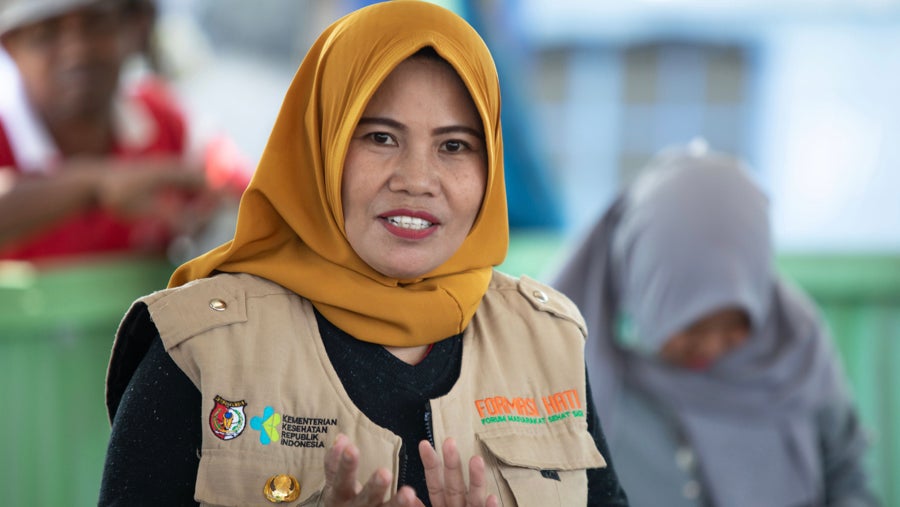
Indonesia: Hatimuna Amd is a village midwife from Balause Health Center in Central Sulawesi, an area that is no stranger to disasters in a country that's one of the most disaster-prone in the world. She supported the provision of sexual and reproductive health services during the flood response in Sigi District in 2019 and after the devastating earthquake in 2018. UNFPA has long worked with the Indonesian Midwives Association across this vast archipelago, to strengthen the capacity of midwives to work in a variety of resource-challenged settings, including amid humanitarian crises. ©UNFPA/Learson

Cambodia: Yeang Botum is a midwife at the Kechong health center in Ratanakiri province. She uses posters to facilitate a discussion with mothers in the community about how to prevent COVID-19 transmission at the household level. Cambodia's health system, practically destroyed amid the brutal Khmer Rouge years, has been gradually rebuilt through the support of UNFPA and other UN partners, with midwifery increasingly prioritized as an essential pillar of sexual and reproductive health in a largely rural nation. ©UN0403590/Antoine Raab

Vanuatu: Syvlie Barang meets with a midwife after Tropical Cyclone Harold devastated her island in early 2020. UNFPA secured $241,000 through the United Nations Central Emergency Response Fund to ensure the life-saving continuity of sexual and reproductive health services in affected provinces. Midwives play a crucial role in Vanuatu and other Pacific island nations frequented by natural disasters year after year, from erupting volcanoes and earthquakes to powerful cyclones and tropical storms. ©UNFPA/Scarlett Hawkins
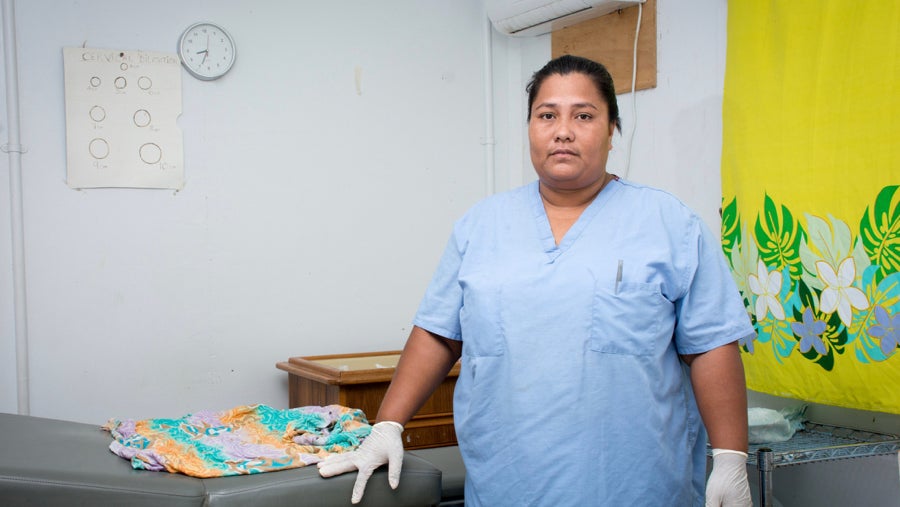
Christmas Island: “We need more assistance to be able to provide the best service for pregnant women,” says Nana Teboko. “We do not have enough nurses working on the island. There is only one nurse for each shift and we can’t afford to attend all patients’ needs at once, especially when we have lots of women due in one go and we have emergency cases.”
Nana has been working as a midwife and nurse in the Australian territory of Christmas Island for over five years. She says the lack of resources forces them to adapt and innovate as best they can.
“We use whatever resources we have to help deliver the baby regardless of the lack of materials or equipment. There are approximately 15-20 babies delivered each month but the delivery set is not fully equipped: there is no trolley, not enough incubators or other equipment needed to monitor and ensure the safety of both mothers and children.“
She says the lack of equipment is only part of the problem.
“The hospital is run down since it's old,” she says. “The floor in the maternity room is cracked. There are holes and you have to be careful where you are stepping otherwise you risk tripping. The whole place needs renovation, even the sink is not working for washing hands.” ©UNICEF/Raimon Kataotao

Cambodia: Lan Sokkhy is a secondary midwife of O Yadav Health Centre in Ratanakiri province. She is responsible for providing maternal and newborn health services at the center in Ten Ngol village and during integrated outreach activities in the surrounding communities. ©UN0403571/Antoine Raab

Sri Lanka: Gowri is the supervising public health midwife in Poonagar, a community in the Eastern Province of Sri Lanka. Midwives help make births safer and promote the right to sexual and reproductive health services. They are key figures in their small, rural communities. In Sri Lanka, UNFPA supports the Ministry of Health to strengthen the capacity and services delivered by midwives. UNFPA has also supported the Family Health Bureau in the revision of the public health midwives curriculum, to ensure that the midwifery workforce is skilled and empowered to provide quality sexual and reproductive health services for their communities. ©UNFPA/Sri Lanka/ Tashiya DeMel

Nepal: Sabita Khadka is a midwife in Nepal who is working on the frontlines of the COVID-19 pandemic response to provide quality care to pregnant women and new mothers. The pandemic and its challenges have tested midwives and other health care providers, especially in the country's far-flung remote and rural reaches. Midwives and other health care personnel have often integrated their service delivery, taking on additional roles and working all the more to reach women in need, often trapped amid pandemic lockdowns and other movement restrictions. ©UNFPA/Nepal

Bangladesh: A day in the life of a midwife in the Rohingya refugee camps of Bangladesh is never dull. The story of Salima Khatum symbolizes that clearly. The young refugee as in the throes of labour when she was rushed to a UNFPA-supported health centre at the Nayapara refugee camp in Cox's Bazar. The story could have ended tragically, but well-trained midwives ensured a happy ending. ©UNFPA/Allison Joyce READ MORE
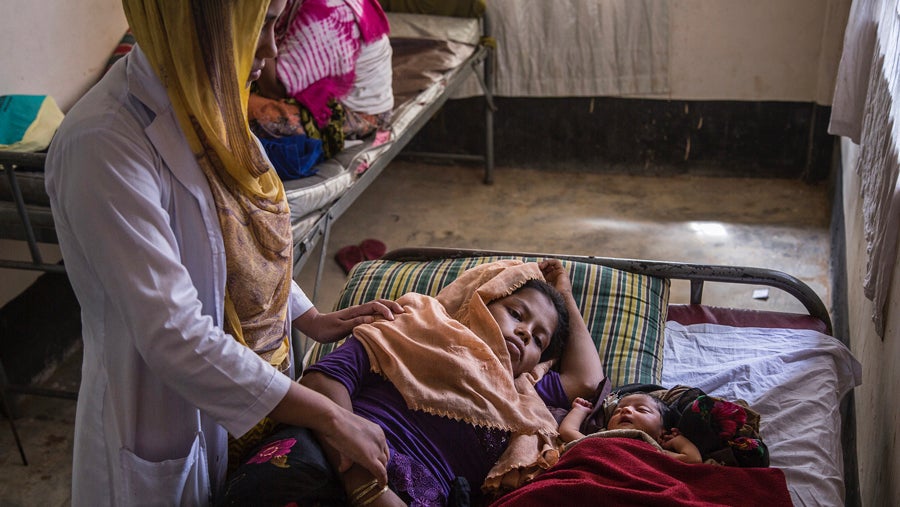
Bangladesh: A midwife checks on exhausted new teenage mother Hazera Begum. She is recuperating next to her sleeping infant, 3-day-old Kismat Ara, at the birthing centre in the Kutupalong camp for Rohingya refugees, in Cox’s Bazar. Hazera spent three days in painful labour trying to give birth in her family’s shed shelter with the help of relatives before she was finally brought to the health facility by her mother and gave birth with the help of midwives. “I was in so much pain,” she said. “I feel safe here.” ©UN0139593/LeMoyne READ MORE

Cambodia: Midwife Kong Kompeak drives her bike down a dirt road on her way to provide services for pregnant mothers in Krong Tes Village, Mundulkiri. Often traveling vast distances on motorcycles, midwives like Kong bring quality care to women and families in rural areas, providing services otherwise inaccessible to remote communities. But, with the onset of COVID-19, this small cadre of midwives must be more careful than ever, ensuring that they don’t contract the deadly virus, or transmit it. READ MORE ©UNFPA/Cambodia

Kiribati: With hospitals often struggling with the challenges of funding, regular flooding events and a host of public health problems, maternal health is an important investment that can be overlooked and under-resourced. UNFPA's engagement with government health partners creates a dialogue about essential equipment and planning for emergencies. ©UNFPA/Learson

Indonesia: Midwife Nurjannah doing a pregnancy checkup with 26-year-old Sumira Waelat Hitu Community Health Centre in Ambon. Sumira’s husband is a fisherman and they don’t have the JKN card (National Health Insurance) coverage. Nurjannah gives them helpful advice on how they can apply for the insurance so she doesn’t have to pay for the delivery, a cost she and her family can ill afford. ©UNI206024/Ijazah

Myanmar: A mother winces in sympathetic pain as midwife Daw Cho Thae vaccinates her child at the Health Center in Pindaya township. For many women, midwives are the primary point of contact for mothers with the healthcare system and they become trusted voices that help women in the transition to motherhood. In a nation scarred by numerous internal conflicts, even before the events of 2021, midwives and other maternal health providers are regarded as pillars of their communities. ©UN0337712/Nyan Zay Htet

Lao PDR: A midwife speaks to a woman about contraception in a health center in a rural community. Midwives play a critical role in opening discussions about family planning and helping women make informed decisions about their reproductive health in a country that has steadily been investing in sexual and reproductive health, strengthening its ability to transition to a higher socioecnomic rung. ©UNFPA/Lao PDR

Lao PDR: Midwives get training in emergency obstetrics at Provincial Health School in Oudomxay. Lao PDR is mostly mountainous and access is notoriously difficult. It’s critical for midwives to be skilled in how to handle complicated births because referrals can be challenging with mountain roads sometimes impassable. UNFPA supports midwives in Lao PDR with emergency obstetrics training so they feel confident to handle tricky cases and save lives. ©UNFPA/Perier
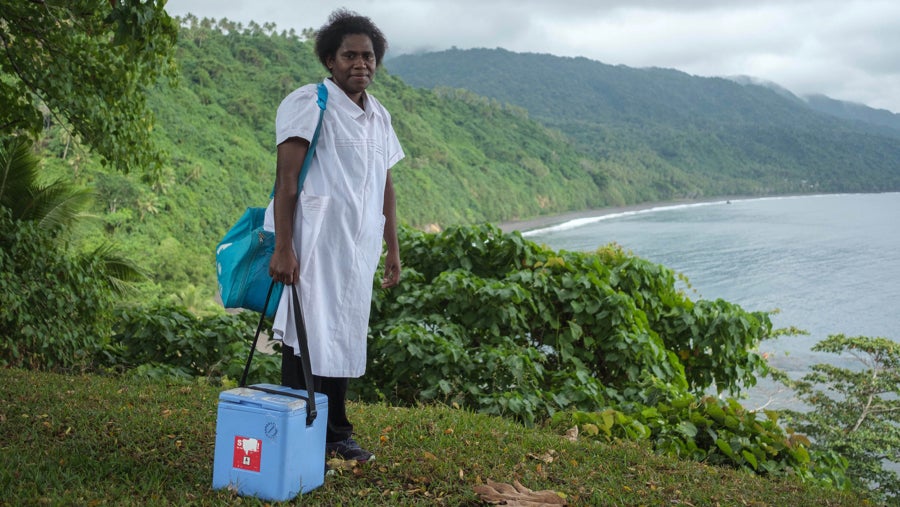
Vanuatu: Midwife Roslinda Narawayan from Vaimali Health Centre on Epi Island. Roslinda and her assistant do a three-hour hike down the coast to deliver vaccines for a clinic at Ngala village. Because there are no fridges to store vaccines, the vaccines must be administered immediately at journey's end. She spent three days trying to contact the nurse at the distant health centre to better coordinate the process, but because of the limited communication network, she decided to just go and get the job done. ©UN0259800/Jason Chute

Australia: “Midwives in every country are critical,” says Dr Caroline Homer. ”The world does not have enough midwives, and where they do have enough midwives, they're probably not in the right places. There are just not enough midwives in the places where women and babies need them the most.”
Professor Homer of Australia is one of the authors of the State of the World's Midwifery Report published in 2021 through the International Confederation of Midwives, WHO and UNFPA. She says midwives need greater support in training and resources to be more effective.
“We need better systems to support midwives to be their best,” she says. “It's not enough just to have lots of training. It's not enough just to send a midwife out to every village and have midwives everywhere. They are not going to be able to make a difference unless they have access to a telephone and access to a vehicle. They must have access to a hospital up the road to transfer women in emergencies.”
The legendary Prof. Homer is Co-Program Director of Women and Children’s Health and Co-Head for the Women’s and Newborn’s Health Working Group at the Burnet Institute in Melbourne. She is also the Visiting Distinguished Professor of Midwifery at the University of Technology Sydney, Australia. READ MORE
Learn more


